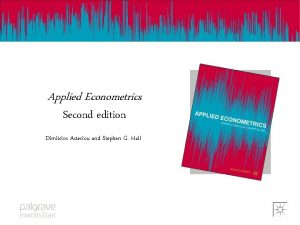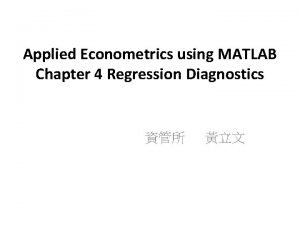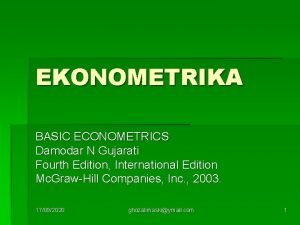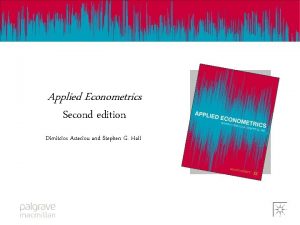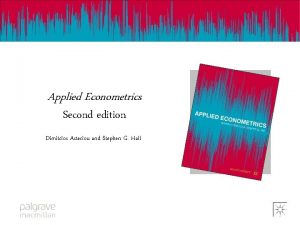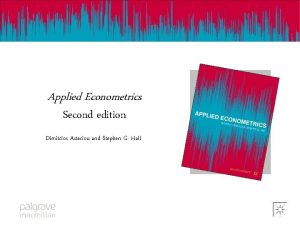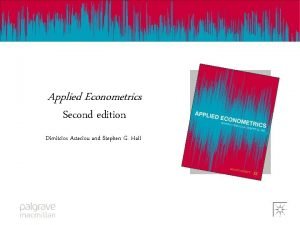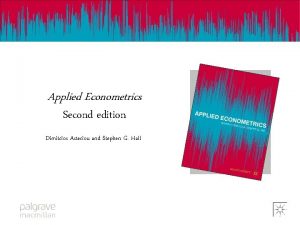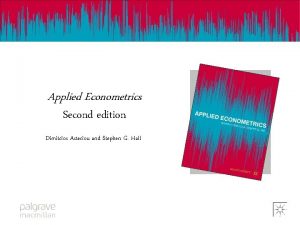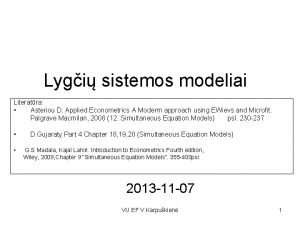Applied Econometrics Second edition Dimitrios Asteriou and Stephen












- Slides: 12

Applied Econometrics Second edition Dimitrios Asteriou and Stephen G. Hall

Applied Econometrics INTRODUCTION 1. What is Econometrics? 2. The Stages of Econometric Work 2

Applied Econometrics What is Econometrics? Econometrics means measurement (metrics in greek) in economics. The importance of applied work in economics is increasing constantly. Theory suggests that X affects Y but is this true or not? This is the work of the applied econometrician.

Applied Econometrics What is Econometrics? • Examples of problems that may be tackled by an Econometrician (a) Modelling long-term relationships among prices and interest rates. (b) Examining the effect of inflation in unemployment rates (c) Examining the effect of disposable income on consumption

Applied Econometrics What is Econometrics? • Examples of problems that may be tackled by an Econometrician (continued) (a) Determining the factors that affect GDP per capita growth (b) Testing the validity of the CAPM and APT theories (c) Forecasting the correlation among the returns and the stock indices of two countries.

Applied Econometrics The Stages of Applied Econometric Analysis Economic Theory Econometric Model Data Model Estimation Specification Testing and Diagnostics Is the Model Adequate? No Yes Test any hypothesis Use for Predictions and Policy Making

Applied Econometrics The Structure of Economic Data • There are three different types of economic data • TIME SERIES • CROSS SECTIONAL • PANEL DATA

Applied Econometrics The Structure of Economic Data • Time Series Data • Examples: GDP, Unemployment, Inflation, Stock Prices, etc • Vectors or Columns (like in a spreadsheet) • Frequencies: Yearly, Bi-annually, Quarterly, Monthly, Weekly, Daily, Hourly. • Lots of different values for different time periods for one country, state, city, market.

Applied Econometrics The Structure of Economic Data • Cross-Sectional Data • Examples: GDP, Unemployment, Inflation, Stock Prices, etc. • Vectors or Rows (like in a spreadsheet) • Frequencies: Yearly, Bi-annually, Quarterly, Monthly, Weekly, Daily, Hourly. • Lots of different values for different countries, states, cities, markets, but for one time period only.

Applied Econometrics The Structure of Economic Data • • • Panel Data A combination of time series and cross-sectional data. Examples: GDP, Unemployment, Inflation, Stock Prices, etc. Matrices (columns and rows to make an n times m matrix) Frequencies: Yearly, Bi-annually, Quarterly, Monthly, Weekly, Daily, Hourly. • Lots of different values for different countries, states, cities, markets, and for different time periods.

Applied Econometrics The Structure of Economic Data - Notation • Time series: Yt, t=1990, 1991, …, 2012 • Cross-Sectional: Yi, i=1, 2, 3, …, 40 • Panel Data: Yit, i and t defined as above. • It is common to denote each observation by the letter t and the total number of observations by T for time series data, and to denote each observation by the letter i and the total number of observations by N for cross-sectional data.

The Structure of Economic Applied Econometrics Data – Quantitative vs Qualitative • The data may be quantitative and qualitative. • Quantitative (e. g. GDP per capita, exchange rates, stock prices, unemployment rates) • Qualitative (e. g. Day of the week, gender, level of education) 12
 Applied econometrics by dimitrios asteriou pdf
Applied econometrics by dimitrios asteriou pdf Applied econometrics using matlab
Applied econometrics using matlab Basic econometrics 4th edition
Basic econometrics 4th edition Dimitrios psaltis
Dimitrios psaltis Dimitrios lymberopoulos
Dimitrios lymberopoulos Dimitrios koutsonikolas
Dimitrios koutsonikolas Dimitrios thomas endocrinologist
Dimitrios thomas endocrinologist Dimitrios dimitriadis
Dimitrios dimitriadis Dr zikos
Dr zikos Dimitrios skarlatos
Dimitrios skarlatos Dimitrios psarros
Dimitrios psarros Invisispec
Invisispec Management by stephen p robbins 9th edition
Management by stephen p robbins 9th edition
